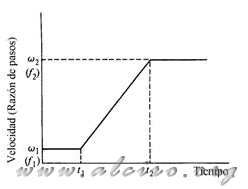5.1.3. Acceleration of stepper motors
Because the engine can not start at the maximum speed of work, since it does not have sufficient torque to pull the load with the inertia that is starting at high speed, you have to run at a low rate of subsequent steps accelerate gradually until reaching the maximum operating speed. Similarly one has to operate to stop the engine, based on a high speed slows down to the unemployment rate without losing steps.
(1) Linear acceleration. When the term of the viscous friction is negligible, then equation 5.1 can be expressed:
 (5.4)
(5.4)
If the motor torque is constant and only considered the range of speed, integration of Equation 5.4 yields:
 (5.5)
(5.5)
or frequency of steps
 (5.6)
(5.6)
where
Ω 1 = angular velocity before the acceleration start
f 1 = frequency of steps before you start acceleration.
Example 1. What is the motor torque required to accelerate a load inertia of 10 -4 m 2 kg * 1 = 100 Ω to Ω 2 = 300 rad * s -1 for 0.1 s, T f is 0.05 N * m?
 (5.7)
(5.7)
Example 2. What is the motor torque required to accelerate an inertial load of 2 * 10-4 Kg * m 2 = 500 Hz f 1 f 2 = 1500 Hz for 50 ms? Friction loads are negligible. The pitch angle is θ s = 1.8 ° = 3.1416 * 10-2 rad.

Figure 5.3. Ω1 linear acceleration to ω2 for t1-t2
 (5.8)
(5.8)
Example 3. What is the maximum acceleration of an inertia load of 10-4 Kg * m 2 driven by a motor with a torque of 0.2 N * m? Friction loads are negligible. The pitch angle is 2 º = 3419 * 10-2 rad.
 (5.9)
(5.9)
(2) exponential acceleration. When the viscous friction torque is not negligible the equation can be written as:
\ =\ 0) (5.10)
(5.10)
If the motor torque is not a function of the ratio of steps or speed, the solution to this differential equation is:
*e^{-(\frac{D}{J})*t}) (5.11)
(5.11)
where
f 1 = ratio of steps at the beginning.
So, the reason for the positive acceleration decreases with the ratio of steps. This type of acceleration is referred to as (exponential acceleration).
When the motor torque TM is decreased with the ratio of steps in a linear fashion, similar to (5.12), the maximum acceleration possible depends on the exponential.
 (5.12)
(5.12)







